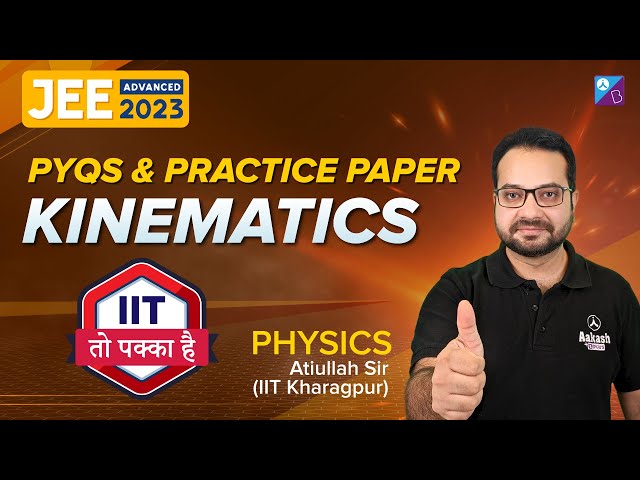The branch of classical mechanics that deals with the study of the motion of the points, objects and a group of objects without considering the causes of motion are called Kinematics. The word kinematics came from the Greek word “kinesis”, meaning motion. Kinematics has its application in astrophysics to study the motion of celestial objects. It is also used in robotics, biomechanics to explain the motion of objects with joint parts such as engines, human skeletons, robotic arms and much more.
Download Kinematics Previous Year Solved Questions PDF
JEE Advanced Previous Year Questions with Solutions on Kinematics
Question 1) Bird is flying in north-east direction with or v = 4√2 m/s with respect to the wind and the wind blowing from north to south with speed 1 m/s. Find the magnitude of the displacement of the bird in 3 sec.
(a) 5 m
(b) 15 m
(c) 10 m
(d) 20 m

Answer: ( b) 15 m
Solution:

Question 2) Four planks are arranged in a lift going upwards with an acceleration of 0.2 m/s2 as shown in the figure. Find the normal reaction applied by the lift on 10 kg block: (g = 9.8 𝑚/𝑠2)

a. 500
b. 700
c. 672
d. 800
Solution: (b) 700

N – 70g = 70 x 0.2
N = 70 (g + 0.2)
N = 700
Question 3) A projectile is thrown from a point O on the ground at an angle 45° from the vertical and with a speed of 5 √2 m/s . The projectile at the highest point of its trajectory splits into two equal parts. One part falls vertically down to the ground, 0.5 s after the splitting. The other part, t seconds after the splitting, falls to the ground at a distance x meters from the point O. The acceleration due to gravity g = 10 m/s2 . The value of t is ________.
Answer: 0.5
Solution:
H = u2sin2θ/2g
Question 4) A projectile is thrown from a point O on the ground at an angle 45° from the vertical and with a speed of 5 √2 m/s . The projectile at the highest point of its trajectory splits into two equal parts. One part falls vertically down to the ground, 0.5 s after the splitting. The other part, t seconds after the splitting, falls to the ground at a distance x meters from the point O. The acceleration due to gravity g = 10 m/s2 .The value of x is ________.
Answer: 7.5
Solution:
X= 3R/2 as Xcm = R
R =u2sin2θ/g
= 50/10 = 5
⇒X = 3R/2 = 15/2 = 7.5 m
Question 5) A particle of mass M = 0.2 kg is initially at rest in the xy-plane at a point (x = –l, y = –h), where l = 10 m and h = 1 m. The particle is accelerated at time t = 0 with a constant acceleration a = 10 m/s2 along the positive x-direction. Its angular momentum and torque with respect to the origin, in SI units, are represented by
(A) The particle arrives at the point (x = l, y = –h) at time t = 2s
(B)
(C)
(D)
Answer: (A,B,C)
Solution:

Question 6) One end of a horizontal uniform beam of weight W and length L is hinged on a vertical wall at point O and its other end is supported by a light inextensible rope. The other end of the rope is fixed at point Q, at a height L above the hinge at point O. A block of weight αW is attached at the point P of the beam, as shown in the figure (not to scale). The rope can sustain a maximum tension of (2√2) W Which of the following statement(s) is(are) correct?

(A) The vertical compenent of reaction force at O does not depend on α
(B) The horizontal component of reaction force at O is equal to W for α = 0.5
(C) The tension in the rope is 2W for α = 0.5
(D) The rope breaks if α > 1.5
Answer: (A,B.D)

Solution:
W x (L/2) + αW x L = T x (1/√2) x L
Fv = W/2
At α = ½ ,
FH (at α = ½) = √2W x ½ = W
At α = 1.5 , T = √2 x (½ + 3/2) W = 2√2W
Question 7) Airplanes A and B are flying with constant velocity in the same vertical plane at angles 300 and 600 with respect to the horizontal respectively as shown in the figure. The speed of A is 100√3 m/s. At time t = 0 s, an observer in A finds B at a distance of 500 m. This observer sees B moving with a constant velocity perpendicular to the line of motion of A. If at t = t0, A just escapes being hit by B, t0 in seconds is

Answer: 5 s
Solution:

vA = vBcos 300
⇒ 100√3 = vB x (√3/2)
⇒ vB = 200 m/s
t0 = d/vBsin 300
= 500/ (200 x ½)
= 5 s
Question 8) A bus is moving with a constant velocity v1 along a horizontal road. A man standing inside the bus throws a ball upward with velocity v0 and catches the ball. The magnitude of displacement of the ball with respect to the ground is
(A) v02/g
(B) Zero
(C)2v0v1/g
(D) v0v1/g
Answer: (C) 2v0v1/g
Solution:
T = 2v0/g
X = 2v0v1/g
Question 9) A particle starts sliding down a frictionless inclined plane. If Sn is the distance travelled by it from time t = (n – 1) sec to t = n sec, then the ratio Sn/Sn+1 is
(A) (2n – 1)/(2n+1)
(B) (2n + 1)/2n
(C) 2n/(2n + 1)
(D) (2n+1)/(2n-1)
Answer: (A) (2n – 1)/(2n+1)
Solution:
Sn = u + (a/2) (2n – 1)
Sn = (gsinθ/2) (2n – 1) ———(1)
Sn+1 = (gsinθ/2) (2n + 1) ———(1)
So, Sn = (2n – 1)/(2n + 1)
Question 10) A particle moving in a straight line covers half the distance with speed of 3 m/s. The other half of the distance is covered in two equal time intervals with speed of 4.5 m/s and 7.5 m/s respectively. The average speed of the particle during this motion is
(A) 4.0 m/s
(B) 5.0 m/s
(C)5.5 m/s
(D) 4.8 m/s
Answer: 1) 4 m/s
Solution:
Let the total distance covered by the particle be S. Given that, the particle covers S/2 with a speed of 3m/s.
The time taken to cover this distance is, (t1/2)/3
t1=S/6
Let the time taken to complete the other half distance be 2t2. We have,
(t2 ×4.5)+ (t2 ×7.5)= S/2
12t2 = S/2
t2 = S/24
The average speed VA = total distance/total time
= S /(t1 + t2)
= S/ {(S/6)+ (S/24)}
VA = 4m/s
Also Read:
Kinematics 1D JEE Main Previous Year Questions With Solutions
Kinematics Previous Year Questions – JEE Advanced

JEE Advanced Physics Important Questions Quiz – 1

Comments